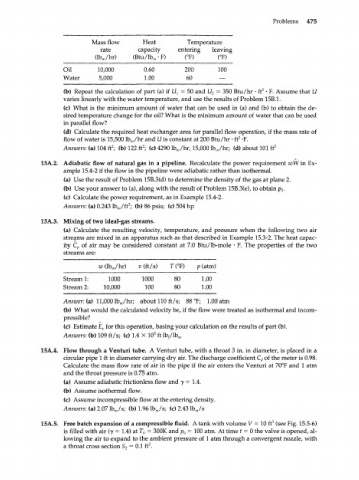Page 495 - Bird R.B. Transport phenomena
P. 495
Problems 475
Mass flow Heat Temperature
rate capacity entering leaving
(lb /hr) (Btu/lb^-F) (°F) (°F)
m
Oil 10,000 0.60 200 100
Water 5,000 1.00 60 —
2
(b) Repeat the calculation of part (a) if U = 50 and U = 350 Btu/hr • ft • F. Assume that U
] 2
varies linearly with the water temperature, and use the results of Problem 15B.1.
(c) What is the minimum amount of water that can be used in (a) and (b) to obtain the de-
sired temperature change for the oil? What is the minimum amount of water that can be used
in parallel flow?
(d) Calculate the required heat exchanger area for parallel flow operation, if the mass rate of
2
flow of water is 15,500 lb /hr and U is constant at 200 Btu/hr • ft -F.
m
2
2
Answers: (a) 104 ft ; (b) 122 ft ; (c) 4290 lb /hr, 15,000 lb /hr; (d) about 101 ft 2
m
m
15A.2. Adiabatic flow of natural gas in a pipeline. Recalculate the power requirement wW in Ex-
ample 15.4-2 if the flow in the pipeline were adiabatic rather than isothermal.
(a) Use the result of Problem 15B.3(d) to determine the density of the gas at plane 2.
(b) Use your answer to (a), along with the result of Problem 15B.3(e), to obtain p .
2
(c) Calculate the power requirement, as in Example 15.4-2.
3
Answers: (a) 0.243 lb /ft ; (b)86psia; (c)504hp
m
15A.3. Mixing of two ideal-gas streams.
(a) Calculate the resulting velocity, temperature, and pressure when the following two air
streams are mixed in an apparatus such as that described in Example 15.3-2. The heat capac-
ity C of air may be considered constant at 7.0 Btu/lb-mole • F. The properties of the two
p
streams are:
wdbjhi) v(tt/s) T(°F) p(atm)
Stream 1: 1000 1000 80 1.00
Stream 2: 10,000 100 80 1.00
Answer: (a) 11,000 lb /hr; about 110 ft/s; 88 °F; 1.00 atm
w
(b) What would the calculated velocity be, if the flow were treated as isothermal and incom-
pressible?
(c) Estimate E for this operation, basing your calculation on the results of part (b).
v
3
Answers: (b) 109 ft/s; (c) 1.4 X 10 ft lb /lb
f m
15A.4. Flow through a Venturi tube. A Venturi tube, with a throat 3 in. in diameter, is placed in a
circular pipe 1 ft in diameter carrying dry air. The discharge coefficient C of the meter is 0.98.
d
Calculate the mass flow rate of air in the pipe if the air enters the Venturi at 70°F and 1 atm
and the throat pressure is 0.75 atm.
(a) Assume adiabatic frictionless flow and у = 1.4.
(b) Assume isothermal flow.
(c) Assume incompressible flow at the entering density.
Answers: (a) 2.07 lb /s; (b) 1.96 lb /s; (c) 2.43 lb /s
ffl
w
m
3
15A.5. Free batch expansion of a compressible fluid. A tank with volume V = 10 ft (see Fig. 15.5-6)
is filled with air (y = 1.4) at T = 300K and p = 100 atm. At time t = 0 the valve is opened, al-
o
0
lowing the air to expand to the ambient pressure of 1 atm through a convergent nozzle, with
a throat cross section S = 0.1 ft .
2
2

